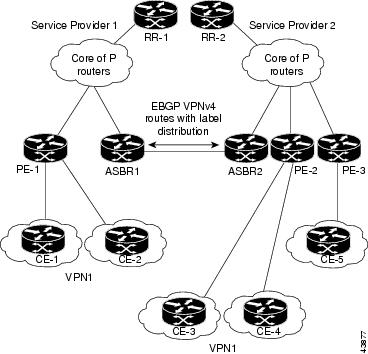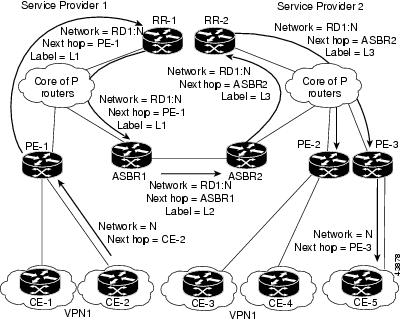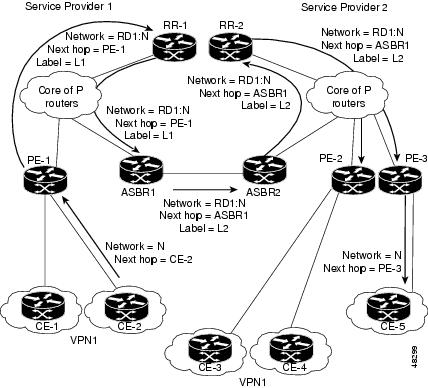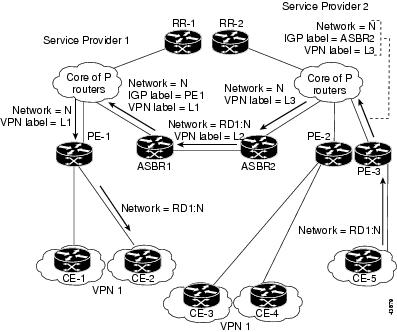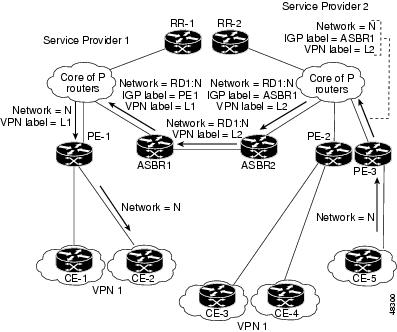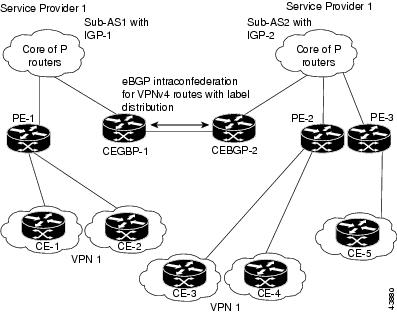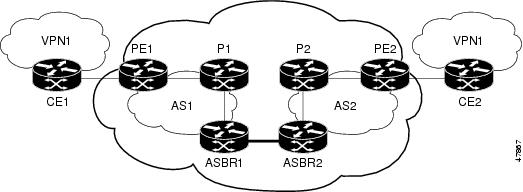 Feedback Feedback
|
Table Of Contents
MPLS VPN—Interautonomous System Support
Routing Between Autonomous Systems
Exchanging VPN Routing Information
Routing Between Subautonomous Systems in a Confederation
Related Features and Technologies
Supported Standards, MIBs, and RFCs
Configuring EBGP Routing for the Exchange of VPN Routes Between Autonomous Systems
Displaying VPN-IPv4 LFIB Entries
Configuring EBGP Routing to Exchange VPN Routes Between Autonomous Systems Examples
Configuration for Autonomous System 1, CE1 Example
Configuration for Autonomous System 1, PE1 Example
Configuration for Autonomous System 1, P1 Example
Configuration for Autonomous System 1, EBGP1 Example
Configuration for Autonomous System 2, EBGP2 Example
Configuration for Autonomous System 2, P2 Example
Configuration for Autonomous System 2, PE2 Example
Configuration for Autonomous System 2, CE2 Example
Configuration for Autonomous System 1, CE1 Example
Configuration for Autonomous System 1, PE1 Example
Configuration for Autonomous System 1, P1 Example
Configuration for Autonomous System 1, EBGP1 Example
Configuration for Autonomous System 2, EBGP2 Example
Configuration for Autonomous System 2, P2 Example
Configuration for Autonomous System 2, PE2 Example
Configuration for Autonomous System 2, CE2 Example
bgp default route-target filter
MPLS VPN—Interautonomous System Support
Feature History
12.1(5)T
This document was introduced.
12.0(16)ST
This feature was integrated into Cisco IOS Release 12.0(16)ST. Support for the Cisco 12000 Series Four-Port OC-3c/STM-1c ATM Line Card (4-Port OC-3 ATM) and the Cisco 12000 Series Four-Port OC-3c/STM-1c POS/SDH Line Card (4-Port OC-3 POS) was added.
12.0(17)ST
This feature was integrated into Cisco IOS Release 12.0(17)ST. Support for the Cisco 12000 series was added (See Table 1 for the Cisco 12000 series line cards supported).
12.0(22)S
This feature was integrated into Cisco IOS Release 12.0(22)S. Support for the Cisco 12000 series, the Cisco 10000 series edge services routers (ESRs), and the Cisco 10720 Internet Routers was added. (See Table 1 for the Cisco 12000 series line cards supported).
This feature module explains how to provide Multiprotocol Label Switching Virtual Private Network (MPLS VPN) services that can span multiple autonomous systems (ASs) and VPN service providers. This document includes the following sections:
•
Supported Standards, MIBs, and RFCs
Feature Overview
The MPLS VPN—Interautonomous System Support feature allows an MPLS VPN to span service providers and autonomous systems.
As VPNs grow, their requirements expand. In some cases, VPNs need to reside on different autonomous systems in different geographic areas. (An autonomous system is a single network or group of networks that is controlled by a common system administration group and that uses a single, clearly defined routing protocol.) Also, some VPNs need to extend across multiple service providers (overlapping VPNs). Regardless of the complexity and location of the VPNs, the connection between autonomous systems must be seamless to the customer.
The MPLS VPN—Interautonomous System Support feature provides seamless integration of autonomous systems and service providers. Separate autonomous systems from different service providers can communicate by exchanging IPv4 Network Layer Reachability Information (NLRI) in the form of VPN-IPv4 addresses. The autonomous systems' border edge routers use Exterior Border Gateway Protocol (EBGP) to exchange that information. Then, an Interior Gateway Protocol (IGP) distributes the network layer information for VPN-IPv4 prefixes throughout each VPN and each autonomous system. Routing information uses the following protocols:
•
Within an autonomous system, routing information is shared using an IGP.
•
Between autonomous systems, routing information is shared using an EBGP. An EBGP allows a service provider to set up an interdomain routing system that guarantees the loop-free exchange of routing information between separate autonomous systems.
An MPLS VPN with interautonomous system support allows a service provider to provide to customers scalable Layer 3 VPN services, such as web hosting, application hosting, interactive learning, electronic commerce, and telephony service. A VPN service provider supplies a secure, IP-based network that shares resources on one or more physical networks.
The primary function of an EBGP is to exchange network reachability information between autonomous systems, including information about the list of autonomous system routes. The autonomous systems use EGBP border edge routers to distribute the routes, which include label switching information. Each border edge router rewrites the next-hop and MPLS labels. See the section "Routing Between Autonomous Systems" for more information.
Interautonomous system configurations supported in an MPLS VPN can include:
•
Interprovider VPN—MPLS VPNs that include two or more autonomous systems, connected by separate border edge routers. The autonomous systems exchange routes using EBGP. No IGP or routing information is exchanged between the autonomous systems.
•
BGP Confederations — MPLS VPNs that divide a single autonomous system into multiple subautonomous systems, and classify them as a single, designated confederation. The network recognizes the confederation as a single autonomous system. The peers in the different autonomous systems communicate over EBGP sessions; however, they can exchange route information as if they were IBGP peers.
Benefits
The MPLS VPN—Interautonomous System Support feature provides the following benefits.
Allows a VPN to Cross More Than One Service Provider Backbone
Service providers, running separate autonomous systems, can jointly offer MPLS VPN services to the same end customer. A VPN can begin at one customer site and traverse different VPN service provider backbones before arriving at another site of the same customer. Previous MPLS VPN could only traverse a single BGP autonomous system service provider backbone. This feature allows multiple autonomous systems to form a continuous (and seamless) network between customer sites of a service provider.
Allows a VPN to Exist in Different Areas
A service provider can create a VPN in different geographic areas. Having all VPN traffic flow through one point (between the areas) allows for better rate control of network traffic between the areas.
Allows Confederations to Optimize IBGP Meshing
IBGP meshing in an autonomous system is more organized and manageable. You can divide an autonomous system into multiple, separate subautonomous systems and then classify them into a single confederation (even though the entire VPN backbone appears as a single autonomous system). This capability allows a service provider to offer MPLS VPNs across the confederation because it supports the exchange of labeled VPN-IPv4 NLRI between the subautonomous systems that form the confederation.
Routing Between Autonomous Systems
Figure 1 illustrates one MPLS VPN consisting of two separate autonomous systems. Each autonomous system operates under different administrative control and runs a different IGP. Service providers exchange routing information through EBGP border edge routers (ASBR1, ASBR2).
Figure 1 EBGP Connection Between Two Autonomous Systems
This configuration uses the following process to transmit information:
Step 1
The provider edge router (PE-1) assigns a label for a route before distributing that route. The PE router uses the multiprotocol extensions of a Border Gateway Protocol (BGP) to transmit label mapping information. The PE router distributes the route as a VPN-IPv4 address. The address label and the VPN identifier are encoded as part of the NLRI.
Step 2
The two route reflectors (RR-1 and RR-2) reflect VPN-IPv4 internal routes within the autonomous system. The autonomous systems' border edge routers (ASBR1 and ASBR2) advertise the VPN-IPv4 external routes.
Step 3
The EBGP border edge router (ASBR1) redistributes the route to the next autonomous system (ASBR2). ASBR1 specifies its own address as the value of the EBGP next hop attribute and assigns a new label. The address ensures the following:
•
That the next hop router is always reachable in the service provider (P) backbone network.
•
That the label assigned by the distributing router is properly interpreted. (The label associated with a route must be assigned by the corresponding next hop router.)
Step 4
The EBGP border edge router (ASBR2) redistributes the route in one of the following ways, depending on its configuration:
•
If the IBGP neighbors are configured with the neighbor next-hop-self command, ASBR2 changes the next hop address of updates received from the EBGP peer, then forwards it on.
•
If the IBGP neighbors are not configured with the neighbor next-hop-self command, the next hop address does not get changed. ASBR2 must propagate a host route for the EBGP peer through the IGP. To propagate the EBGP VPN-IPv4 neighbor host route, use the redistribute connected subnets command. The EBGP VPN-IPv4 neighbor host route is automatically installed in the routing table when the neighbor comes up. This is essential to establish the label-switched path between PE routers in different autonomous systems.
Exchanging VPN Routing Information
Autonomous systems exchange VPN routing information (routes and labels) to establish connections. To control connections between autonomous systems, the PE routers and EBGP border edge routers maintain a label forwarding information base (LFIB). The LFIB manages the labels and routes that the PE routers and EBGP border edge routers receive during the exchange of VPN information.
Figure 2 illustrates the exchange of VPN route and label information between autonomous systems. The autonomous systems use the following guidelines to exchange VPN routing information:
•
Routing information includes:
–
The destination network (N)
–
The next hop field associated with the distributing router
–
A local MPLS label (L)
•
An RD1: route distinguisher is part of a destination network address to make the VPN-IPv4 route globally unique in the VPN service provider environment.
•
The ASBRs are configured to change the next hop (next-hop-self) when sending VPN-IPv4 NLRIs to the IBGP neighbors. Therefore, the ASBRs must allocate a new label when they forward the NLRI to the IBGP neighbors.
Figure 2 Exchanging Routes and Labels Between Autonomous Systems in an Interprovider VPN Network
Figure 3 illustrates the exchange of VPN route and label information between autonomous systems. The only difference is that ASBR2 is configured with the redistribute connected command, which propagates the host routes to all PEs. The redistribute connected command is necessary because ASBR2 is not configured to change the next hop address.
Figure 3 Exchanging Routes and Labels Between Autonomous Systems in an Interprovider VPN Network with the redistributed connected Command
Packet Forwarding
Figure 4 illustrates how packets are forwarded between autonomous systems in an interprovider network using the following packet forwarding method.
Packets are forwarded to their destination by means of MPLS. Packets use the routing information stored in the LFIB of each PE router and EBGP border edge router.
The service provider VPN backbone uses dynamic label switching to forward labels.
Each autonomous system uses standard multilevel labeling to forward packets between the edges of the autonomous system routers (for example, from CE-5 to PE-3). Between autonomous systems, only a single level of labeling is used, corresponding to the advertised route.
A data packet carries two levels of labels when traversing the VPN backbone:
•
The first label (IGP route label) directs the packet to the correct PE router or EBGP border edge router. (For example, the IGP label of ASBR2 points to the ASBR2 border edge router.)
•
The second label (VPN route label) directs the packet to the appropriate PE router or EBGP border edge router.
Figure 4 Forwarding Packets Between Autonomous Systems in an Interprovider VPN Network
Figure 5 illustrates shows the same packet forwarding method, except the EBGP router (ASBR1) forwards the packet without reassigning it a new label.
Figure 5 Forwarding Packets Between Autonomous Systems in an Interprovider VPN Network Without a New Label Assignment
Routing Between Subautonomous Systems in a Confederation
A VPN can span service providers running in separate autonomous systems or between multiple subautonomous systems that have been grouped together to form a confederation.
A confederation reduces the total number of peer devices in an autonomous system. A confederation divides an autonomous system into subautonomous systems and assigns a confederation identifier to the autonomous systems.
In a confederation, each subautonomous system is fully meshed with other subautonomous systems. The subautonomous systems communicate using an IGP, such as Open Shortest Path First (OSPF) or Intermediate System-to-Intermediate System (IS-IS). Each subautonomous system also has an EBGP connection to the other subautonomous systems. The confederation EBGP (CEBGP) border edge routers forward next-hop-self addresses between the specified subautonomous systems. The next-hop-self address forces the BGP to use a specified address as the next hop rather than letting the protocol choose the next hop.
You can configure a confederation with separate subautonomous systems in two ways:
•
You can configure a router to forward next-hop-self addresses between only the CEBGP border edge routers (both directions). The subautonomous systems (IBGP peers) at the subautonomous system border do not forward the next-hop-self address. Each subautonomous system runs as a single IGP domain. However, the CEBGP border edge router addresses are known in the IGP domains.
•
You can configure a router to forward next-hop-self addresses between the CEBGP border edge routers (both directions) and within the IBGP peers at the subautonomous system border. Each subautonomous system runs as a single IGP domain but also forwards next-hop-self addresses between the PE routers in the domain. The CEBGP border edge router addresses are known in the IGP domains.
Note
Figure 2 and Figure 3 illustrate how two autonomous systems exchange routes and forward packets. subautonomous systems in a confederation use a similar method of exchanging routes and forwarding packets.
Figure 6 illustrates a typical MPLS VPN confederation configuration. In this confederation configuration:
•
The two CEBGP border edge routers exchange VPN-IPv4 addresses with labels between the two subautonomous systems.
•
The distributing router changes the next-hop addresses and labels and uses a next-hop-self address.
•
IGP-1 and IGP-2 know the addresses of CEBGP-1 and CEBGP-2.
Figure 6 EBGP Connection Between Two Subautonomous Systems in a Confederation
In this confederation configuration:
•
CEBGP border edge routers function as neighboring peers between the subautonomous systems. The subautonomous systems use EBGP to exchange route information.
•
Each CEBGP border edge router (CEBGP-1, CEBGP-2) assigns a label for the route before distributing the route to the next subautonomous system. The CEBGP border edge router distributes the route as an VPN-IPv4 address by using the multiprotocol extensions of BGP. The label and the VPN identifier are encoded as part of the NLRI.
•
Each PE and CEBGP border edge router assigns its own label to each VPN-IPv4 address prefix before redistributing the routes. The CEBGP border edge routers exchange VPN-IPv4 addresses with the labels. The next-hop-self address is included in the label (as the value of the EBGP next-hop attribute). Within the subautonomous systems, the CEBGP border edge router address is distributed throughout the IBGP neighbors and the two CEBGP border edge routers are known to both confederations.
Restrictions
A VPN-IPv4 EBGP session must be configured between directly connected ASBRs. Multihop VPN-IPv4 EBGP is not supported.
Related Features and Technologies
The MPLS VPN—Interautonomous System Support feature is used with the VPN capabilities of MPLS. MPLS VPNs were introduced in Cisco IOS Release 12.0(5)T.
Related Documents
•
MPLS Virtual Private Networks (VPNs)
•
MPLS Virtual Private Network Enhancements
•
Cisco IOS Switching Services Configuration Guide (Release 12.2), Multiprotocol Label Switching
Supported Platforms
The following router platforms are supported at the service provider edge:
•
Cisco 7200 series
•
Cisco 7500 series
•
Cisco 10000 series edge services routers (ESRs)
•
Cisco 10720 Internet Routers
•
Cisco 12000 series
Table 1 lists the Cisco 12000 series line card support added for Cisco IOS Releases.
Determining Platform Support Through Cisco Feature Navigator
Cisco IOS software is packaged in feature sets that support specific platforms. To get updated information regarding platform support for this feature, access Cisco Feature Navigator. Cisco Feature Navigator dynamically updates the list of supported platforms as new platform support is added for the feature.
Cisco Feature Navigator is a web-based tool that enables you to determine which Cisco IOS software images support a specific set of features and which features are supported in a specific Cisco IOS image. You can search by feature or release. Under the release section, you can compare releases side by side to display both the features unique to each software release and the features in common.
To access Cisco Feature Navigator, you must have an account on Cisco.com. If you have forgotten or lost your account information, send a blank e-mail to cco-locksmith@cisco.com. An automatic check will verify that your e-mail address is registered with Cisco.com. If the check is successful, account details with a new random password will be e-mailed to you. Qualified users can establish an account on Cisco.com by following the directions at http://www.cisco.com/register.
Cisco Feature Navigator is updated regularly when major Cisco IOS software releases and technology releases occur. For the most current information, go to the Cisco Feature Navigator home page at the following URL:
Availability of Cisco IOS Software Images
Platform support for particular Cisco IOS software releases is dependent on the availability of the software images for those platforms. Software images for some platforms may be deferred, delayed, or changed without prior notice. For updated information about platform support and availability of software images for each Cisco IOS software release, refer to the online release notes or, if supported, Cisco Feature Navigator.
Supported Standards, MIBs, and RFCs
Standards
No new or modified standards are supported by this feature.
MIBs
No new or modified MIBs are supported by this feature.
To obtain lists of supported MIBs by platform and Cisco IOS release, and to download MIB modules, go to the Cisco MIB website on Cisco.com at the following URL:
http://www.cisco.com/public/sw-center/netmgmt/cmtk/mibs.shtml
RFCs
•
RFC 1771, A Border Gateway Protocol 4
•
RFC 1965, Autonomous System Confederation for BGP
•
RFC 1164, Application of the Border Gateway Protocol in the Internet
•
RFC 2842, Capabilities Advertisement with BGP-4
•
RFC 2283, Multiprotocol Extensions for BGP-4
•
RFC 2547, BGP/MPLS VPNs
Standards
•
Internet draft draft-ramachandra-bgp-ext-communities-08.txt, BGP Extended Community Attribute
Prerequisites
The network must be properly configured for MPLS VPN operation before you configure interautonomous systems. Refer to the following documents for MPLS VPN network configuration details:
•
MPLS Virtual Private Networks (VPNs)
•
MPLS Virtual Private Network Enhancements
•
Cisco IOS Switching Services Configuration Guide, Release 12.2
Configuration Tasks
To configure the exchange of VPN-IPv4 addresses between two or more autonomous systems or subautonomous systems in a confederation, perform the following tasks:
•
Configuring EBGP Routing for the Exchange of VPN Routes Between Autonomous Systems (required)
•
Configuring EBGP Routing for the Exchange of VPN Routes Between Subautonomous Systems in a Confederation (required)
•
Displaying VPN-IPv4 LFIB Entries (optional)
Before You Begin
Before you configure EBGP routing between autonomous systems or subautonomous systems in an MPLS VPN, ensure that you have properly configured all MPLS VPN routing instances and sessions. The configuration tasks outlined in this section build from those configuration tasks.
Perform (as appropriate to the existing network configuration) the following tasks as described in the Cisco IOS Switching Services Configuration Guide (the Configuring Multiprotocol Label Switching chapter).
•
Define VPN routing instances
•
Configure BGP routing sessions in the service provider (P) network
•
Configure PE to PE routing sessions in the service provider (P) network
•
Configure BGP PE to CE routing sessions
Configuring EBGP Routing for the Exchange of VPN Routes Between Autonomous Systems
To configure an EBGP border edge router in an autonomous system to exchange VPN routes with another autonomous system, use the following commands starting in EXEC mode.
Note
Issue the redistribute connected subnets command in the IGP configuration portion of the router to propagate host routes for VPN-IPv4 EBGP neighbors to other routers and provider edge routers. Alternatively, you can specify the next-hop-self address when you configure IBGP neighbors.
Configuring EBGP Routing for the Exchange of VPN Routes Between Subautonomous Systems in a Confederation
To configure EBGP border edge router in a confederation to exchange VPN routes with another subautonomous system, use the following commands starting in EXEC mode.
Note
To ensure that the host routes for VPN-IPv4 EBGP neighbors are propagated (by means of the IGP) to the other routers and provider edge routers, specify the redistribute connected command in the IGP configuration portion of the CEBGP router. If you are using OSPF, make sure that the OSPF process is not enabled on the CEBGP interface where the "redistribute connected" subnet exists.
Note
In this confederation, subautonomous system IGP domains must know the addresses of CEBGP-1 and CEBGP-2. If you do not specify a next-hop-self address as part of the router configuration, ensure that the addresses of all PE routers in the subautonomous system are distributed throughout the network, not just the addresses of CEBGP-1 and CEBGP-2.
Displaying VPN-IPv4 LFIB Entries
To display the VPN-IPv4 label forwarding information base (LFIB) entries at the border edge routers in the autonomous systems, use the following commands starting in EXEC mode:
The following is an example of how the VPN-IPv4 LFIB entries appear when you use the show tag-switching forwarding-table privileged EXEC command:
Router#show tag-switching forwarding-tableLocal Outgoing Prefix Bytes tag Outgoing Next Hoptag tag or VC or Tunnel Id switched interface33 33 10.120.4.0/24 0 Hs0/0 point2point35 27 100:12:10.200.0.1/32 \0 Hs0/0 point2point
Note
In this example, the Prefix field appears as a VPN-IPv4 route distinguisher (RD), plus the prefix. If the value is longer than the Prefix column (as illustrated in the last line of the example), the output automatically wraps onto the next line in the forwarding table to preserve column alignment.
Configuration Examples
This section provides the following configuration examples:
•
Configuring EBGP Routing to Exchange VPN Routes Between Autonomous Systems Examples
Configuring EBGP Routing to Exchange VPN Routes Between Autonomous Systems Examples
The network topology in Figure 7 shows two autonomous systems, which are configured as follows:
•
Autonomous system 1 (AS1) includes PE1, P1, EBGP1. The IGP is OSPF.
•
Autonomous system 2 (AS2) includes PE2, P2, EBGP2. The IGP is ISIS.
•
CE1 and CE2 belongs to the same VPN, which is called VPN1.
•
The P routers are route reflectors.
•
EBGP1 is configured with the redistribute connected subnets command.
•
EBGP2 is configured with the neighbor next-hop-self command.
Figure 7 Configuring Two Autonomous Systems
Configuration for Autonomous System 1, CE1 Example
CE1: Burlington!interface Loopback1ip address 1.0.0.6 255.255.255.255!interface Serial1/3description Veritasno ip addressencapsulation frame-relayframe-relay intf-type dce!interface Serial1/3.1 point-to-pointdescription Veritasip address 1.6.2.1 255.255.255.252frame-relay interface-dlci 22!router ospf 1network 1.0.0.0 0.255.255.255 area 0Configuration for Autonomous System 1, PE1 Example
PE1: Veritas!ip cef!ip vrf V1rd 1:105route-target export 1:100route-target import 1:100!interface Serial0/0description Burlingtonno ip addressencapsulation frame-relayno fair-queueclockrate 2000000!interface Serial0/0.3 point-to-pointdescription Burlingtonip vrf forwarding V1ip address 1.6.2.2 255.255.255.252frame-relay interface-dlci 22!interface Ethernet0/1description Vermontip address 100.2.2.5 255.255.255.0tag-switching ip!router ospf 1log-adjacency-changesnetwork 100.0.0.0 0.255.255.255 area 0!router ospf 10 vrf V1log-adjacency-changesredistribute bgp 1 metric 100 subnetsnetwork 1.0.0.0 0.255.255.255 area 0!router bgp 1no synchronizationneighbor R peer-groupneighbor R remote-as 1neighbor R update-source Loopback0neighbor 100.0.0.2 peer-group Rno auto-summary!address-family ipv4 vrf V1redistribute ospf 10no auto-summaryno synchronizationexit-address-family!address-family vpnv4neighbor R activateneighbor R send-community extendedneighbor 100.0.0.2 peer-group Rno auto-summaryexit-address-familyConfiguration for Autonomous System 1, P1 Example
P1: Vermont!ip cef!interface Loopback0ip address 100.0.0.2 255.255.255.255!interface Ethernet0/1description Ogunquitip address 100.2.1.1 255.255.255.0tag-switching ip!interface FastEthernet2/0description Veritasip address 100.2.2.1 255.255.255.0duplex autospeed autotag-switching ip!router ospf 1log-adjacency-changesnetwork 100.0.0.0 0.255.255.255 area 0!router bgp 1no synchronizationbgp log-neighbor-changesneighbor R peer-groupneighbor R remote-as 1neighbor R update-source Loopback0neighbor R route-reflector-clientneighbor 100.0.0.4 peer-group Rneighbor 100.0.0.5 peer-group R!address-family vpnv4neighbor R activateneighbor R route-reflector-clientneighbor R send-community extendedneighbor 100.0.0.4 peer-group Rneighbor 100.0.0.5 peer-group Rexit-address-familyConfiguration for Autonomous System 1, EBGP1 Example
EBGP1: Ogunquit!ip cef!interface Loopback0ip address 100.0.0.4 255.255.255.255!interface Ethernet0/1description Vermontip address 100.2.1.40 255.255.255.0tag-switching ip!interface ATM1/0description Lowellno ip addressno atm scrambling cell-payloadno atm ilmi-keepalive!interface ATM1/0.1 point-to-pointdescription Lowellip address 12.0.0.1 255.255.255.252pvc 1/100!router ospf 1log-adjacency-changesredistribute connected subnetsnetwork 100.0.0.0 0.255.255.255 area 0!router bgp 1no synchronizationno bgp default route-target filterbgp log-neighbor-changesneighbor R peer-groupneighbor R remote-as 1neighbor R update-source Loopback0neighbor 12.0.0.2 remote-as 2neighbor 100.0.0.2 peer-group Rno auto-summary!address-family vpnv4neighbor R activateneighbor R send-community extendedneighbor 12.0.0.2 activateneighbor 12.0.0.2 send-community extendedneighbor 100.0.0.2 peer-group Rno auto-summaryexit-address-familyConfiguration for Autonomous System 2, EBGP2 Example
EBGP2: Lowell!ip cef!ip vrf V1rd 2:103route-target export 1:100route-target import 1:100!interface Loopback0ip address 200.0.0.3 255.255.255.255ip router isis!interface Loopback1ip vrf forwarding V1ip address 1.0.0.3 255.255.255.255!interface Serial0/0description Littletonno ip addressencapsulation frame-relayload-interval 30no fair-queueclockrate 2000000!interface Serial0/0.2 point-to-pointdescription Littletonip unnumbered Loopback0ip router isistag-switching ipframe-relay interface-dlci 23!interface ATM1/0description Ogunquitno ip addressatm clock INTERNALno atm scrambling cell-payloadno atm ilmi-keepalive!interface ATM1/0.1 point-to-pointdescription Ogunquitip address 12.0.0.2 255.255.255.252pvc 1/100!router isisnet 49.0002.0000.0000.0003.00!router bgp 2no synchronizationno bgp default route-target filterbgp log-neighbor-changesneighbor 12.0.0.1 remote-as 1neighbor 200.0.0.8 remote-as 2neighbor 200.0.0.8 update-source Loopback0neighbor 200.0.0.8 next-hop-self!address-family ipv4 vrf V1redistribute connectedno auto-summaryno synchronizationexit-address-family!address-family vpnv4neighbor 12.0.0.1 activateneighbor 12.0.0.1 send-community extendedneighbor 200.0.0.8 activateneighbor 200.0.0.8 next-hop-selfneighbor 200.0.0.8 send-community extendedexit-address-familyConfiguration for Autonomous System 2, P2 Example
P2: Littleton!ip cef!ip vrf V1rd 2:108route-target export 1:100route-target import 1:100!interface Loopback0ip address 200.0.0.8 255.255.255.255ip router isis!interface Loopback1ip vrf forwarding V1ip address 1.0.0.8 255.255.255.255!interface FastEthernet0/0description Paxip address 200.9.1.2 255.255.255.0ip router isistag-switching ip!interface Serial5/0description Lowellno ip addressencapsulation frame-relayframe-relay intf-type dce!interface Serial5/0.1 point-to-pointdescription Lowellip unnumbered Loopback0ip router isistag-switching ipframe-relay interface-dlci 23!router isisnet 49.0002.0000.0000.0008.00!router bgp 2no synchronizationbgp log-neighbor-changesneighbor R peer-groupneighbor R remote-as 2neighbor R update-source Loopback0neighbor R route-reflector-clientneighbor 200.0.0.3 peer-group Rneighbor 200.0.0.9 peer-group R!address-family ipv4 vrf V1redistribute connectedno auto-summaryno synchronizationexit-address-family!address-family vpnv4neighbor R activateneighbor R route-reflector-clientneighbor R send-community extendedneighbor 200.0.0.3 peer-group Rneighbor 200.0.0.9 peer-group Rexit-address-familyConfiguration for Autonomous System 2, PE2 Example
PE2: Pax!ip cef!ip vrf V1rd 2:109route-target export 1:100route-target import 1:100!interface Loopback0ip address 200.0.0.9 255.255.255.255ip router isis!interface Loopback1ip vrf forwarding V1ip address 1.0.0.9 255.255.255.255!interface Serial0/0description Bethelno ip addressencapsulation frame-relayframe-relay intf-type dceno fair-queueclockrate 2000000!interface Serial0/0.1 point-to-pointdescription Bethelip vrf forwarding V1ip unnumbered Loopback1frame-relay interface-dlci 24!interface FastEthernet0/1description Littletonip address 200.9.1.1 255.255.255.0ip router isistag-switching ip!router ospf 10 vrf V1log-adjacency-changesredistribute bgp 2 subnetsnetwork 1.0.0.0 0.255.255.255 area 0!router isisnet 49.0002.0000.0000.0009.00!router bgp 2no synchronizationbgp log-neighbor-changesneighbor 200.0.0.8 remote-as 2neighbor 200.0.0.8 update-source Loopback0!address-family ipv4 vrf V1redistribute connectedredistribute ospf 10no auto-summaryno synchronizationexit-address-familyaddress-family vpnv4neighbor 200.0.0.8 activateneighbor 200.0.0.8 send-community extendedexit-address-familyConfiguration for Autonomous System 2, CE2 Example
CE2: Bethel!interface Loopback0ip address 1.0.0.11 255.255.255.255!interface Serial0description Paxno ip addressencapsulation frame-relayno fair-queueclockrate 2000000!interface Serial0.1 point-to-pointdescription Paxip unnumbered Loopback0frame-relay interface-dlci 24!router ospf 1network 1.0.0.0 0.255.255.255 area 0Configuring EBGP Routing to Exchange VPN Routes Between Autonomous Systems in a Confederation Examples
The network topology in Figure 8 shows a single Internet service provider (ISP), which is partitioning the backbone with confederations. The AS number of the provider is 100. The two autonomous systems run their own IGPs and are configured as follows:
•
Autonomous system 1 (AS1) includes PE1, P1, EBGP1. The IGP is OSPF.
•
Autonomous system 2 (AS2) includes PE2, P2, EBGP2. The IGP is ISIS.
•
CE1 and CE2 belongs to the same VPN, which is called VPN1.
•
The P routers are route reflectors.
•
EBGP1 is configured with the redistribute connected subnets command.
•
EBGP2 is configured with the neighbor next-hop-self command.
Figure 8 Configuring Two Autonomous Systems in a Confederation
Configuration for Autonomous System 1, CE1 Example
CE1: Burlington!interface Loopback1ip address 1.0.0.6 255.255.255.255!interface Serial1/3description Veritasno ip addressencapsulation frame-relayframe-relay intf-type dce!interface Serial1/3.1 point-to-pointdescription Veritasip address 1.6.2.1 255.255.255.252frame-relay interface-dlci 22!router ospf 1network 1.0.0.0 0.255.255.255 area 0Configuration for Autonomous System 1, PE1 Example
PE1: Veritas!ip cef!ip vrf V1rd 1:105route-target export 1:100route-target import 1:100!interface Serial0/0description Burlingtonno ip addressencapsulation frame-relayno fair-queueclockrate 2000000!interface Serial0/0.3 point-to-pointdescription Burlingtonip vrf forwarding V1ip address 1.6.2.2 255.255.255.252frame-relay interface-dlci 22!interface Ethernet0/1description Vermontip address 100.2.2.5 255.255.255.0tag-switching ip!router ospf 1log-adjacency-changesnetwork 100.0.0.0 0.255.255.255 area 0!router ospf 10 vrf V1log-adjacency-changesredistribute bgp 1 metric 100 subnetsnetwork 1.0.0.0 0.255.255.255 area 0!router bgp 1no synchronizationbgp confederation identifier 100bgp confederation identifier 100neighbor R peer-groupneighbor R remote-as 1neighbor R update-source Loopback0neighbor 100.0.0.2 peer-group Rno auto-summary!address-family ipv4 vrf V1redistribute ospf 10no auto-summaryno synchronizationexit-address-family!address-family vpnv4neighbor R activateneighbor R send-community extendedneighbor 100.0.0.2 peer-group Rno auto-summaryexit-address-familyConfiguration for Autonomous System 1, P1 Example
P1: Vermont!ip cef!interface Loopback0ip address 100.0.0.2 255.255.255.255!interface Ethernet0/1description Ogunquitip address 100.2.1.1 255.255.255.0tag-switching ip!interface FastEthernet2/0description Veritasip address 100.2.2.1 255.255.255.0duplex autospeed autotag-switching ip!router ospf 1log-adjacency-changesnetwork 100.0.0.0 0.255.255.255 area 0!router bgp 1no synchronizationbgp log-neighbor-changesbgp confederation identifier 100neighbor R peer-groupneighbor R remote-as 1neighbor R update-source Loopback0neighbor R route-reflector-clientneighbor 100.0.0.4 peer-group Rneighbor 100.0.0.5 peer-group R!address-family vpnv4neighbor R activateneighbor R route-reflector-clientneighbor R send-community extendedneighbor 100.0.0.4 peer-group Rneighbor 100.0.0.5 peer-group Rexit-address-familyConfiguration for Autonomous System 1, EBGP1 Example
EBGP1: Ogunquit!ip cef!interface Loopback0ip address 100.0.0.4 255.255.255.255!interface Ethernet0/1description Vermontip address 100.2.1.40 255.255.255.0tag-switching ip!interface ATM1/0description Lowellno ip addressno atm scrambling cell-payloadno atm ilmi-keepalive!interface ATM1/0.1 point-to-pointdescription Lowellip address 12.0.0.1 255.255.255.252pvc 1/100!router ospf 1log-adjacency-changesredistribute connected subnetsnetwork 100.0.0.0 0.255.255.255 area 0!router bgp 1no synchronizationno bgp default route-target filterbgp log-neighbor-changesbgp confederation identifier 100bgp confederation peers 1neighbor R peer-groupneighbor R remote-as 1neighbor R update-source Loopback0neighbor 12.0.0.2 remote-as 2neighbor 12.0.0.2 next-hop-selfneighbor 100.0.0.2 peer-group Rno auto-summary!address-family vpnv4neighbor R activateneighbor R send-community extendedneighbor 12.0.0.2 activateneighbor 12.0.0.2 next-hop-selfneighbor 12.0.0.2 send-community extendedneighbor 100.0.0.2 peer-group Rno auto-summaryexit-address-familyConfiguration for Autonomous System 2, EBGP2 Example
EBGP2: Lowell!ip cef!ip vrf V1rd 2:103route-target export 1:100route-target import 1:100!interface Loopback0ip address 200.0.0.3 255.255.255.255ip router isis!interface Loopback1ip vrf forwarding V1ip address 1.0.0.3 255.255.255.255!interface Serial0/0description Littletonno ip addressencapsulation frame-relayload-interval 30no fair-queueclockrate 2000000!interface Serial0/0.2 point-to-pointdescription Littletonip unnumbered Loopback0ip router isistag-switching ipframe-relay interface-dlci 23!interface ATM1/0description Ogunquitno ip addressatm clock INTERNALno atm scrambling cell-payloadno atm ilmi-keepalive!interface ATM1/0.1 point-to-pointdescription Ogunquitip address 12.0.0.2 255.255.255.252pvc 1/100!router isisnet 49.0002.0000.0000.0003.00!router bgp 2no synchronizationno bgp default route-target filterbgp log-neighbor-changesbgp confederation identifier 100bgp confederation peers 1neighbor 12.0.0.1 remote-as 1neighbor 12.0.0.1 next-hop-selfneighbor 200.0.0.8 remote-as 2neighbor 200.0.0.8 update-source Loopback0neighbor 200.0.0.8 next-hop-self!address-family ipv4 vrf V1redistribute connectedno auto-summaryno synchronizationexit-address-family!address-family vpnv4neighbor 12.0.0.1 activateneighbor 12.0.0.1 next-hop-selfneighbor 12.0.0.1 send-community extendedneighbor 200.0.0.8 activateneighbor 200.0.0.8 next-hop-selfneighbor 200.0.0.8 send-community extendedexit-address-familyConfiguration for Autonomous System 2, P2 Example
P2: Littleton!ip cef!ip vrf V1rd 2:108route-target export 1:100route-target import 1:100!interface Loopback0ip address 200.0.0.8 255.255.255.255ip router isis!interface Loopback1ip vrf forwarding V1ip address 1.0.0.8 255.255.255.255!interface FastEthernet0/0description Paxip address 200.9.1.2 255.255.255.0ip router isistag-switching ip!interface Serial5/0description Lowellno ip addressencapsulation frame-relayframe-relay intf-type dce!interface Serial5/0.1 point-to-pointdescription Lowellip unnumbered Loopback0ip router isistag-switching ipframe-relay interface-dlci 23!router isisnet 49.0002.0000.0000.0008.00!router bgp 2no synchronizationbgp log-neighbor-changesbgp confederation identifier 100neighbor R peer-groupneighbor R remote-as 2neighbor R update-source Loopback0neighbor R route-reflector-clientneighbor 200.0.0.3 peer-group Rneighbor 200.0.0.9 peer-group R!address-family ipv4 vrf V1redistribute connectedno auto-summaryno synchronizationexit-address-family!address-family vpnv4neighbor R activateneighbor R route-reflector-clientneighbor R send-community extendedneighbor 200.0.0.3 peer-group Rneighbor 200.0.0.9 peer-group Rexit-address-familyConfiguration for Autonomous System 2, PE2 Example
PE2: Pax!ip cef!ip vrf V1rd 2:109route-target export 1:100route-target import 1:100!interface Loopback0ip address 200.0.0.9 255.255.255.255ip router isis!interface Loopback1ip vrf forwarding V1ip address 1.0.0.9 255.255.255.255!interface Serial0/0description Bethelno ip addressencapsulation frame-relayframe-relay intf-type dceno fair-queueclockrate 2000000!interface Serial0/0.1 point-to-pointdescription Bethelip vrf forwarding V1ip unnumbered Loopback1frame-relay interface-dlci 24!interface FastEthernet0/1description Littletonip address 200.9.1.1 255.255.255.0ip router isistag-switching ip!router ospf 10 vrf V1log-adjacency-changesredistribute bgp 2 subnetsnetwork 1.0.0.0 0.255.255.255 area 0!router isisnet 49.0002.0000.0000.0009.00!router bgp 2no synchronizationbgp log-neighbor-changesbgp confederation identifier 100neighbor 200.0.0.8 remote-as 2neighbor 200.0.0.8 update-source Loopback0!address-family ipv4 vrf V1redistribute connectedredistribute ospf 10no auto-summaryno synchronizationexit-address-familyaddress-family vpnv4neighbor 200.0.0.8 activateneighbor 200.0.0.8 send-community extendedexit-address-familyConfiguration for Autonomous System 2, CE2 Example
CE2: Bethel!interface Loopback0ip address 1.0.0.11 255.255.255.255!interface Serial0description Paxno ip addressencapsulation frame-relayno fair-queueclockrate 2000000!interface Serial0.1 point-to-pointdescription Paxip unnumbered Loopback0frame-relay interface-dlci 24!router ospf 1network 1.0.0.0 0.255.255.255 area 0Command Reference
This section documents the following new command related to interautonomous system MPLS VPN operation:
•
bgp default route-target filter
All other commands used with this feature are described in the following Cisco IOS documentation:
•
MPLS Virtual Private Networks (VPNs)
•
MPLS Virtual Private Network Enhancements
•
Cisco IOS Switching Services Configuration Guide (Release 12.2), Multiprotocol Label Switching
bgp default route-target filter
To enable automatic Border Gateway Protocol (BGP) route-target community filtering, use the bgp default route-target filter command in router configuration mode. To disable this feature, use the no form of this command.
bgp default route-target filter
no bgp default route-target filter
Syntax Description
This command has no arguments or keywords.
Defaults
This command is enabled by default.
Command Modes
Router configuration
Command History
Usage Guidelines
You use this command to control the distribution of VPN routing information through the list of VPN route-target communities.
When you use the no form of this command, all received VPN-IPv4 routes are accepted by the configured router. Accepting VPN-IPv4 routes is the desired behavior for a router configured as an autonomous system border edge router or as a Confederation Exterior Border Gateway Protocol (CEBGP) border edge router.
If you configure the router for BGP route-target community filtering, all received EBGP VPN-IPv4 routes are discarded when those routes do not contain a route-target community value that matches the import list of any configured VRFs. This is the desired behavior for a router configured as a PE router.
Note
This command is automatically disabled if a PE router is configured as a client of a common VPN-IPv4 route reflector in the autonomous system.
Examples
In the following example, BGP route target filtering is disabled for autonomous system 120:
Router(config)# router bgp 120Router(config-router)# no bgp default route-target filterRelated Commands
Glossary
autonomous system—A collection of networks under a common administration sharing a common routing strategy.
BGP—Border Gateway Protocol. An interdomain routing protocol that exchanges network reachability information with other BGP systems (which may be within the same autonomous system or between multiple autonomous systems).
CEBGP—Confederation Exterior Border Gateway Protocol. A BGP between routers located within different subautonomous systems of a confederation. See EBGP and IBGP.
CE router—customer edge router. A router that is part of a customer network and that interfaces to a provider edge (PE) router. CE routers do not recognize associated MPLS VPNs.
confederation—An autonomous system divided into multiple, separate subautonomous systems and classified as a single unit.
EBGP—Exterior Border Gateway Protocol. A BGP between routers located within different autonomous systems. When two routers, located in different autonomous systems, are more than one hop away from one another, the EBGP session between the two routers is considered a multihop BGP.
IBGP—Interior Border Gateway Protocol. A BGP between routers within the same autonomous system.
IGP—Interior Gateway Protocol. Internet protocol used to exchange routing information within a single autonomous system. Examples of common Internet IGP protocols include IGRP, OSPF, IS-IS, and RIP.
LFIB—label forwarding information base. Data structure used in MPLS to hold information about incoming and outgoing labels and associated Forwarding Equivalence Class (FEC) packets.
MPLS—Multiprotocol Label Switching. The name of the IETF working group responsible for label switching, and the name of the label switching approach it has standardized.
NLRI—Network Layer Reachability Information. The BGP sends routing update messages containing NLRI to describe a route and how to get there. In this context, an NLRI is a prefix. A BGP update message carries one or more NLRI prefixes and the attributes of a route for the NLRI prefixes; the route attributes include a BGP next hop gateway address and extended community values.
PE router—provider edge router. A router that is part of a service provider's network. It is connected to a customer edge (CE) router and all MPLS VPN processing occurs in the PE router.
RD—route distinguisher. An 8-byte value that is concatenated with an IPv4 prefix to create a unique VPN-IPv4 prefix.
VPN—Virtual Private Network. A secure MPLS-based network that shares resources on one or more physical networks (typically implemented by one or more service providers). A VPN contains geographically dispersed sites that can communicate securely over a shared backbone network.
VRF table —VPN routing/forwarding table. A VRF consists of an IP routing table, a derived forwarding table, a set of interfaces that use the forwarding table, and a set of rules and routing protocols that determine what goes into the forwarding table. A VRF includes the routing information that defines a customer VPN site that is attached to a PE router.
